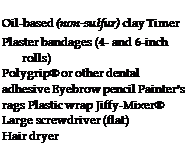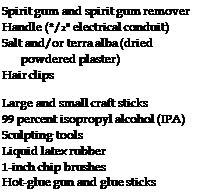There are almost as many variations in the list of materials used for making a life – cast as there are artists who do them. That’s a bit of an exaggeration, but there is no one set list of materials used. Most artists continue to use the materials with which they were taught the process, working from the adage: If it ain’t broke, don’t fix it. Other artists continue to experiment with materials to become more efficient and achieve higher quality. Dave Parvin continues to experiment and develop fresh methods for streamlining the lifecasting process for both himself and his models.
Dave is arguably one of the finest lifecasters in the world and uses procedures and materials that might not be appropriate for beginners. For example, Dave
eschews the use of plaster bandages for making mother (support shell) molds and prefers instead to brush impression dental plaster directly onto the alginate mold, laying small pieces of cheesecloth onto it and painting plaster into the cheesecloth for reinforcement. Dave does this less for economic reasons (plaster bandages can be expensive; impression dental plaster is far less expensive) but because he’s exceptionally good at it. Dave also says this is the best, most efficient method as well for ensuring that the resulting cast comes out flawlessly. I’ve tried it several times and always wind up wasting more plaster than I care to think about. Dave thinks I should just get better at it. (I’m working on it!) It is also less expensive Dave’s way; one box of a dozen 6-inch plaster bandage rolls costs more than a 100-pound bag of impression dental plaster.
A number of commercially available alginates are of sufficient quality for prosthetics work, including FiberGel® and MoldGel® from EnvironMolds in Summit, New Jersey; Accu-Cast Imperial Body Gel® and Accu-Cast 390, 680, and 880 by Accu-Cast of Bend, Oregon; Prosthetic Grade Cream (PGC) by Teledyn-Getz, and Algiform® from Pink House Studios in St. Albans, Vermont. A more extensive list of suppliers can be found in the appendix at the back of this book.
![]()
 |
 |
Following is a list of the materials and tools you will need to create a lifecast from start to finished stone (gypsum) positive made from the alginate lifecast. As I mentioned, there is no one prescribed list of tools and materials, and the following list is in no particular order of importance nor necessarily comprehensive, but lifecasting is relatively standardized throughout the industry, so for the most part consider this list complete. After you’ve become proficient at lifecasting, I’m sure you’ll decide to modify the list to suit your needs. This list also includes materials you may use to sculpt your character makeup appliance in clay once the lifecast has been made.
 |
 |
 |
You might not use all the materials listed here, but these are all common to lifecasting procedures, and you may find that you prefer some over others. They are listed only as a convenience for you to decide what fits best your style.
